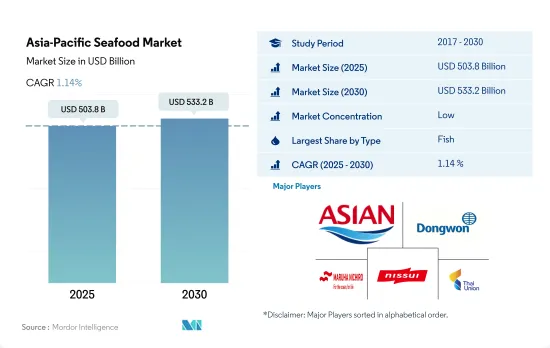Need help finding what you are looking for?
Contact Us
PUBLISHER: Mordor Intelligence | PRODUCT CODE: 1692052

PUBLISHER: Mordor Intelligence | PRODUCT CODE: 1692052
Asia-Pacific Seafood - Market Share Analysis, Industry Trends & Statistics, Growth Forecasts (2025 - 2030)
PUBLISHED:
PAGES: 227 Pages
DELIVERY TIME: 2-3 business days
SELECT AN OPTION
The Asia-Pacific Seafood Market size is estimated at 503.8 billion USD in 2025, and is expected to reach 533.2 billion USD by 2030, growing at a CAGR of 1.14% during the forecast period (2025-2030).

Increasing in food establishments in the region is boosting the market's growth
- In 2022, the fish type segment occupied a 61% higher market share than the other seafood type segment and a 68.4% higher market share than the shrimp segment. The fish type segment registered a growth of 21.2% by value from 2016 to 2021, mainly due to an increase in the population, which led to an increase in consumer preference for fish due to its affordable cost compared to shrimp and other seafood. In 2022, each person consumed twice as much fish as 50 years ago on average.
- Shrimp is expected to be the fastest-growing seafood type consumed in Asia-Pacific, registering a CAGR of 2.07% by value during the forecast period. China accounts for around 60% of total shrimp sales in the Asia-Pacific region. The increase in HRI players like food establishments rose to 1.2% from 2021, reaching 9.7 million restaurants by 2022 after the COVID-19 pandemic. Food establishments are attracting customers through the change in menus, such as the addition of seafood menus like shrimps and varied tastes of seafood across the Asia Pacific region, which is expected to drive sales and increase market share.
- The COVID-19 pandemic disrupted seafood supply chains through factors such as a shortage of workers and lack of automation, which impacted all stakeholders from 2020 to 2021. To mitigate the risk associated with this type of outbreak, the industry saw increased investments in logistics, packaging, and automation of seafood in countries like China and India. Big companies like Thai Union started using satellite technology for advanced traceability and increased their online presence through food and home deliveries, which further boosted company sales. The industry witnessed around 70 million people shopping online in Southeast Asia from 2019 to 2021.
The market is primarily driven by rising health awareness
- In the Asia-Pacific market, seafood sales increased by 12.99% by value from 2017 to 2022. Non-vegetarian consumers in the region are gradually adopting a more pescatarian lifestyle. Due to customers' growing inclination toward a healthy diet, this movement has been noticed. Asia accounted for 73% of the seafood sales worldwide in 2022 and consumed more than two-thirds of the available seafood supply.
- In 2022, China accounted for a significant share of 49.64% by value in the Asia-Pacific seafood market. The high domestic demand for seafood in China is because of growing consumer perceptions that seafood is a healthy source of protein, along with a rising preference for seafood products among middle-class consumers owing to increasing disposable incomes. With growing spending on seafood in the country, the market is anticipated to experience a growth in demand for high-quality, value-added fish and seafood products.
- Indonesia accounted for the second-highest share in the Asia-Pacific fish market, with 10.44% by value in 2022. The country's government is taking initiatives to protect local fisheries as most of Indonesia's fisheries are over-exploited or fully exploited, with illegal fishing practices being common. Organizations such as The Nature Conservancy are transforming fishery practices in Indonesia by monitoring fish stocks, tracking fishing vessels, developing species identification technology, promoting rights-based management in small near-shore fisheries, and other initiatives. Japan is one of the other major markets where the government's Fisheries Agency is working to increase the number of fish caught by improving resource management policies. Such initiatives are increasing the food self-sufficiency rate across Asia-Pacific countries.
Asia-Pacific Seafood Market Trends
Southeast Asian countries account for the major production share
Price growth can majorly be attributed to rising supply chain costs
Asia-Pacific Seafood Industry Overview
Additional Benefits:
Product Code: 90348
TABLE OF CONTENTS
1 EXECUTIVE SUMMARY & KEY FINDINGS
2 INTRODUCTION
- 2.1 Study Assumptions & Market Definition
- 2.2 Scope of the Study
- 2.3 Research Methodology
3 KEY INDUSTRY TRENDS
- 3.1 Price Trends
- 3.1.1 Fish
- 3.1.2 Shrimp
- 3.2 Production Trends
4 MARKET SEGMENTATION (includes market size in Value in USD, Forecasts up to 2030 and analysis of growth prospects)
5 COMPETITIVE LANDSCAPE
6 KEY STRATEGIC QUESTIONS FOR SEAFOOD INDUSTRY CEOS
7 APPENDIX
Have a question?


SELECT AN OPTION
Have a question?


Questions? Please give us a call or visit the contact form.
